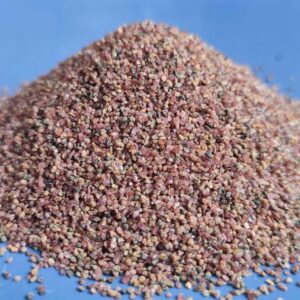
Garnet is a highly versatile abrasive, widely used in industries for blasting and waterjet cutting. Its hardness, durability, and eco-friendly properties make it a preferred choice for many applications. However, for end-users, selecting the right garnet isn’t just about performance—there are several key aspects they consider to ensure optimal results and cost-efficiency.
In this post, we’ll explore the major factors that end-users prioritize when choosing garnet, with real-life examples that demonstrate how these considerations come into play.
1. Hardness and Durability: Getting the Most Out of Your Garnet
One of the first things end-users focus on is the hardness and durability of garnet. The harder the garnet, the better it is at cutting or blasting through tough materials. Durability also matters because reusable garnet can significantly lower operating costs.
Real-life Example: An Australian shipyard found that using hard, durable garnet significantly improved their sandblasting efficiency. Instead of replacing the abrasive after every use, they could recycle it up to five times, cutting costs by nearly 40%. The high hardness allowed them to quickly remove old coatings and corrosion from steel ship hulls, speeding up the entire process without compromising quality.
2. Particle Size and Shape: Precision and Efficiency
For waterjet cutting and blasting, the particle size and shape of the garnet directly affect performance. In waterjet cutting, finer garnet particles provide smoother cuts, while in blasting, larger particles offer a more aggressive cleaning action. Additionally, uniform particle shapes help reduce clogging and improve flow consistency.
Real-life Example: In a large-scale construction project, a company using waterjet cutting to shape stone slabs faced frequent nozzle clogs, causing downtime. After switching to a more uniform, high-quality garnet with finer particles, their cutting precision improved, and the clogging issue disappeared. As a result, they experienced fewer interruptions, increased productivity, and saved on maintenance costs.
3. Purity: Minimizing Contamination Risks
Garnet with a high purity level is essential to avoid contaminants that could affect the quality of the process or damage equipment. Impure garnet can introduce unwanted materials into the blasting or cutting process, potentially ruining finishes or reducing cutting accuracy.
Real-life Example: A metal fabrication plant in Germany switched to high-purity garnet after noticing that impurities in their abrasive were leaving residue on the cut surfaces. This residue required extra cleaning, leading to higher labor costs and longer project timelines. After the switch, they saw an immediate improvement in cut quality and reduced the need for post-processing.
4. Density: Powering Up Cutting and Blasting
Density is another important factor for end-users. Higher-density garnet particles have more mass, which increases cutting and blasting power. In waterjet cutting, this results in faster, more efficient cutting, while in blasting, it improves material removal rates.
Real-life Example: In the oil and gas industry, companies often face the challenge of removing tough coatings from pipelines. A Houston-based service provider switched to a denser garnet abrasive, which allowed them to remove thick, epoxy coatings faster than before. This switch reduced the time spent on each job, enabling the company to take on more projects without increasing manpower.
5. Cost-Effectiveness: Balancing Price and Performance
Cost is always a major consideration for end-users. Garnet that offers a balance between price, performance, and reusability is highly sought after. Users look for garnet that can be recycled multiple times to keep operational costs low, without sacrificing performance.
Real-life Example: A waterjet cutting company in Singapore found that by switching to a slightly more expensive but longer-lasting garnet, they were able to reduce their overall costs. The new garnet not only lasted longer but also performed better, resulting in fewer wasted materials and higher cutting precision. Over six months, they saved more than 15% in operating costs due to reduced abrasive consumption and higher efficiency.
6. Environmental Impact: Choosing Sustainable Solutions
In recent years, environmental sustainability has become a crucial factor for many companies. Garnet, being a naturally occurring mineral that can be recycled, is favored for its low environmental impact compared to other abrasives. Many end-users prioritize materials that align with their environmental policies or certifications.
Real-life Example: A European automotive manufacturer was seeking an eco-friendly abrasive for surface preparation in their production line. After considering several options, they chose garnet because it is non-toxic, does not produce hazardous dust, and can be reused multiple times. This decision helped the company meet its sustainability targets and reduce waste disposal costs.
7. Availability and Supply Consistency
For industries with high demand, consistent availability of garnet is crucial. Unreliable supply chains can cause delays in production, leading to costly downtime. End-users value suppliers who can provide a steady and reliable flow of garnet throughout the year.
Real-life Example: A U.S.-based aerospace parts manufacturer relies on garnet for both waterjet cutting and surface preparation. In the past, inconsistent supply chains led to shortages, causing production delays and increased costs. They partnered with a supplier offering guaranteed year-round availability, ensuring that they never ran out of materials again. This reliability allowed them to maintain tight production schedules and meet client deadlines consistently.
Conclusion
Choosing the right garnet for blasting and waterjet cutting requires more than just finding the hardest or cheapest option. End-users must consider factors like hardness, particle size and shape, purity, density, cost-effectiveness, environmental impact, and availability to make an informed decision. By understanding these key characteristics, businesses can optimize their processes, reduce costs, and improve the quality of their work.
